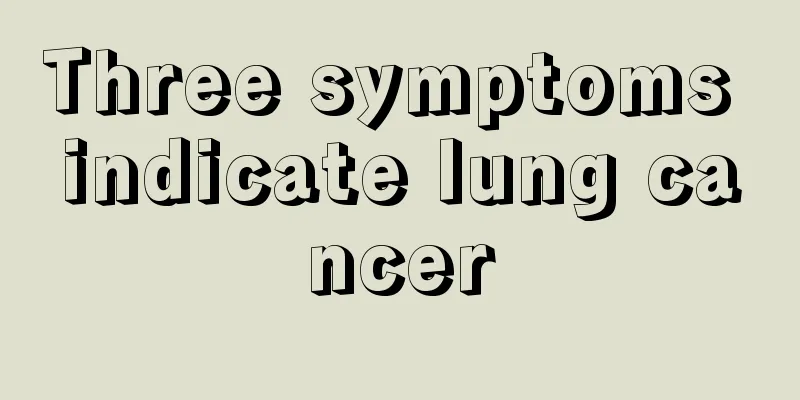Three symptoms indicate lung cancer

|
There are no three symptoms that indicate lung cancer. The definitive diagnosis of lung cancer is pathological examination. However, lung cancer patients may experience persistent cough, hemoptysis or bloody sputum, chest pain, weight loss, and dyspnea. In order to detect and treat lung cancer in a timely manner, you should pay close attention to possible symptoms and symptom changes. The details are as follows: 1. Persistent cough: Lung cancer patients often have unexplained persistent coughs that gradually worsen. If a persistent cough occurs, seek medical attention immediately and have a chest X-ray or CT scan to determine if a tumor is present. If lung cancer is diagnosed, the patient should receive chemotherapy, radiotherapy, or surgery under the guidance of a doctor. 2. Hemoptysis or bloody sputum: Lung cancer patients may cough up blood or bloody sputum, which is a manifestation of lung tumor invasion of blood vessels. If hemoptysis or bloody sputum symptoms occur, you should seek medical attention immediately and confirm the condition through bronchoscopy and sputum cytology. After the diagnosis is confirmed, appropriate treatment plans should be taken under the guidance of a doctor, such as surgical removal of the tumor or radiotherapy and chemotherapy. 3. Chest pain: Chest pain caused by lung cancer is usually persistent and has a clear location, unrelated to respiratory activity. If you experience persistent chest pain of unknown cause, you should seek medical attention as soon as possible and have a chest imaging examination to rule out lung tumors. After lung cancer is diagnosed, surgery, radiotherapy, or chemotherapy should be selected based on the specific location and stage of the tumor. 4. Weight loss: Lung cancer patients often experience significant weight loss in a short period of time without other obvious reasons. If unexplained rapid weight loss occurs, you should seek medical attention as soon as possible to determine the cause through a detailed physical examination and laboratory tests. After lung cancer is diagnosed, comprehensive treatment measures should be taken according to the specific situation, such as nutritional support therapy and anti-tumor therapy. 5. Dyspnea: Lung cancer may cause airway obstruction or damage to the lung parenchyma, which can cause dyspnea. If dyspnea occurs, seek medical attention immediately and determine the cause through pulmonary function tests and imaging tests. After lung cancer is diagnosed, appropriate treatment measures such as bronchodilator therapy and anti-tumor therapy should be taken under the guidance of a doctor. In order to detect and treat lung cancer in time, we should pay close attention to the changes in these symptoms and seek medical attention in time when abnormalities occur. Treatments for lung cancer include surgery, radiotherapy and chemotherapy. The appropriate treatment plan should be selected under the guidance of a doctor according to the specific condition. |
>>: Early symptoms of testicular cancer
Recommend
How to enhance immunity? Eat foods rich in vitamin C regularly
Immunity is very important for each of us. If the...
Does drinking coffee cause hair loss?
Coffee is a slightly stimulating drink. Drinking ...
What are the ways to care for dry and dandruffy leg skin in winter
Dry and flaky skin on the legs is a common sympto...
What kind of razor is good
Razors are very important for many men. They are ...
What foods are good for liver cancer patients? The best recipes for liver cancer patients
Liver cancer patients consume a lot of energy, so...
How long can you live if pancreatic cancer spreads to the liver in the late stage
Pancreatic cancer is one of the common malignant ...
How to treat bone injuries
Many people often suffer physical injuries due to...
Pay more attention to diet when treating rectal cancer
As one of the digestive tract diseases, the treat...
What should we pay attention to in the safe care of patients with rectal cancer
Rectal cancer is a common malignant tumor of the ...
What are the specific dietary remedies for lung cancer? Lung cancer patients can try these three dietary remedies
Because of the current living environment, many p...
What are the symptoms and causes of encephalomyelitis?
Encephalomyelitis is a common disease that occurs...
What kind of exercise is good for people with bile duct cancer
Cancer is also called malignant tumor, and its op...
How to solve the symptoms of liver and gallbladder meridian obstruction?
The function of the liver and gallbladder is to e...
What to do if the iron pan is rusted
Many people like to cook with iron pots. Using ir...
What to do if the red blood streaks on the calves itch
Red blood streaks are mainly caused by capillary ...









